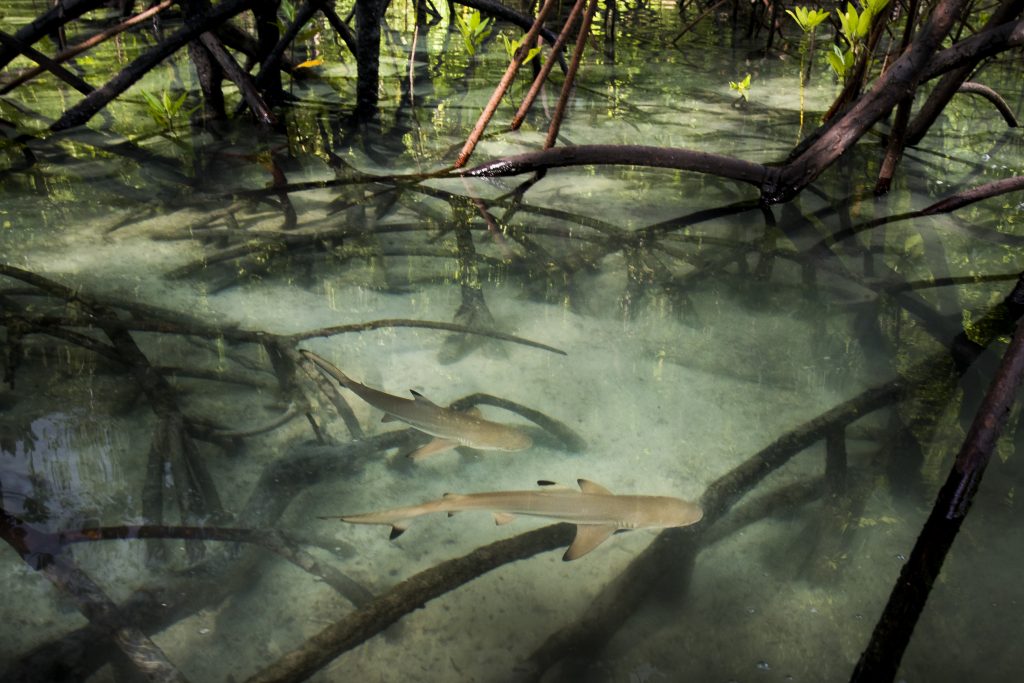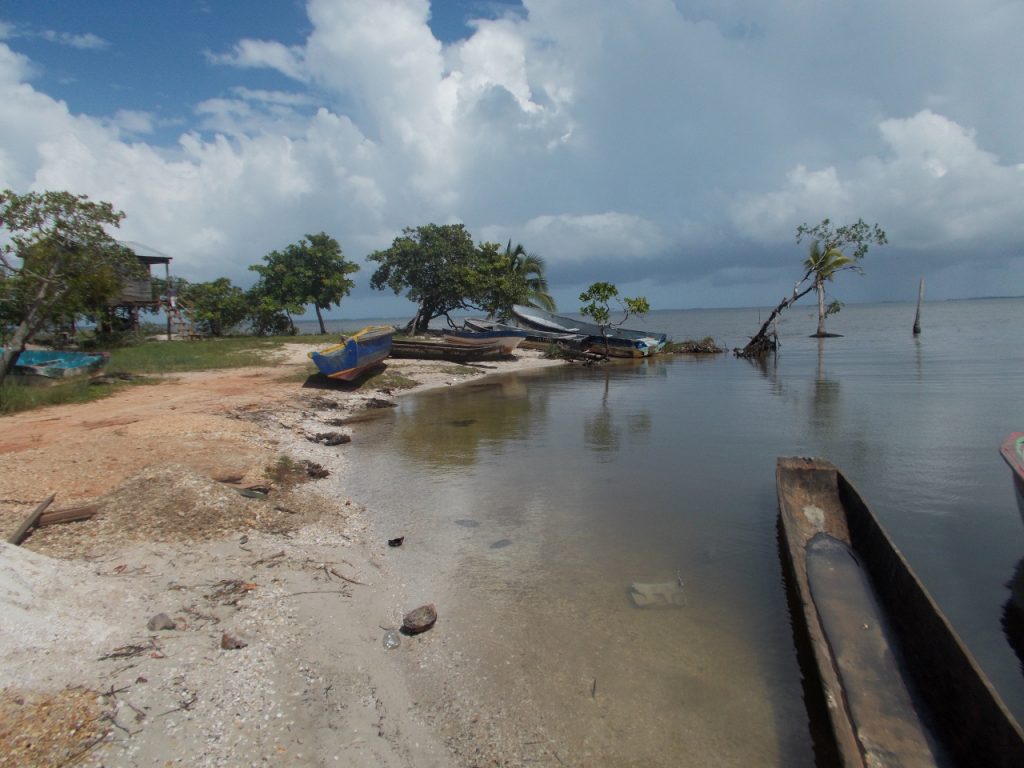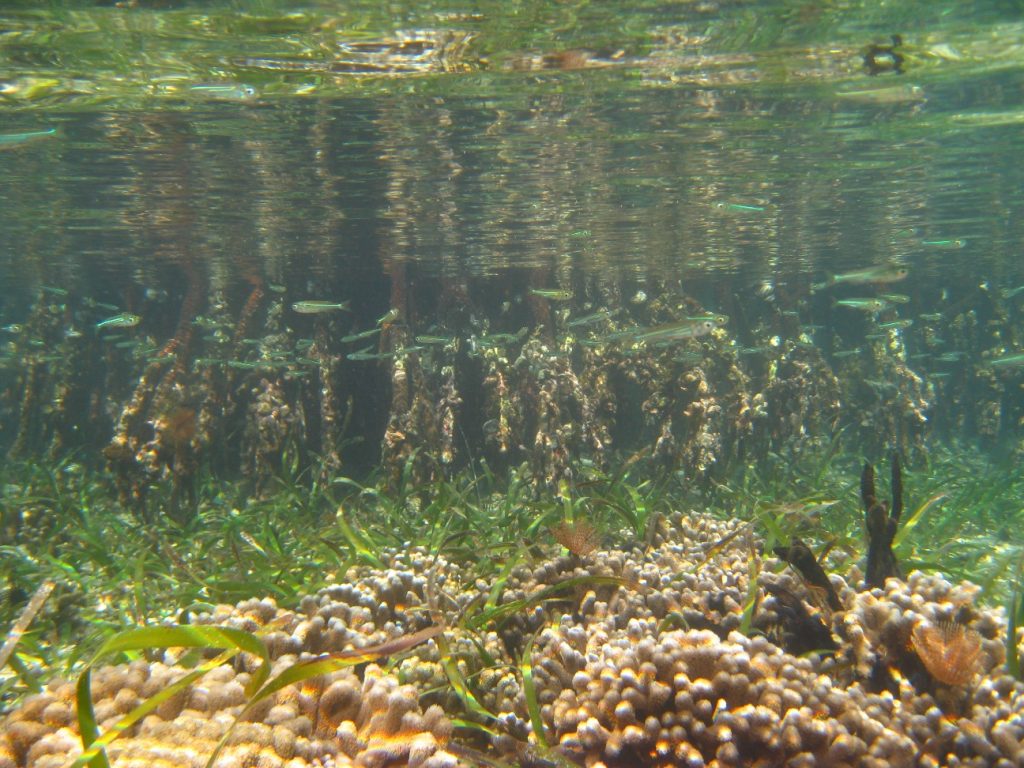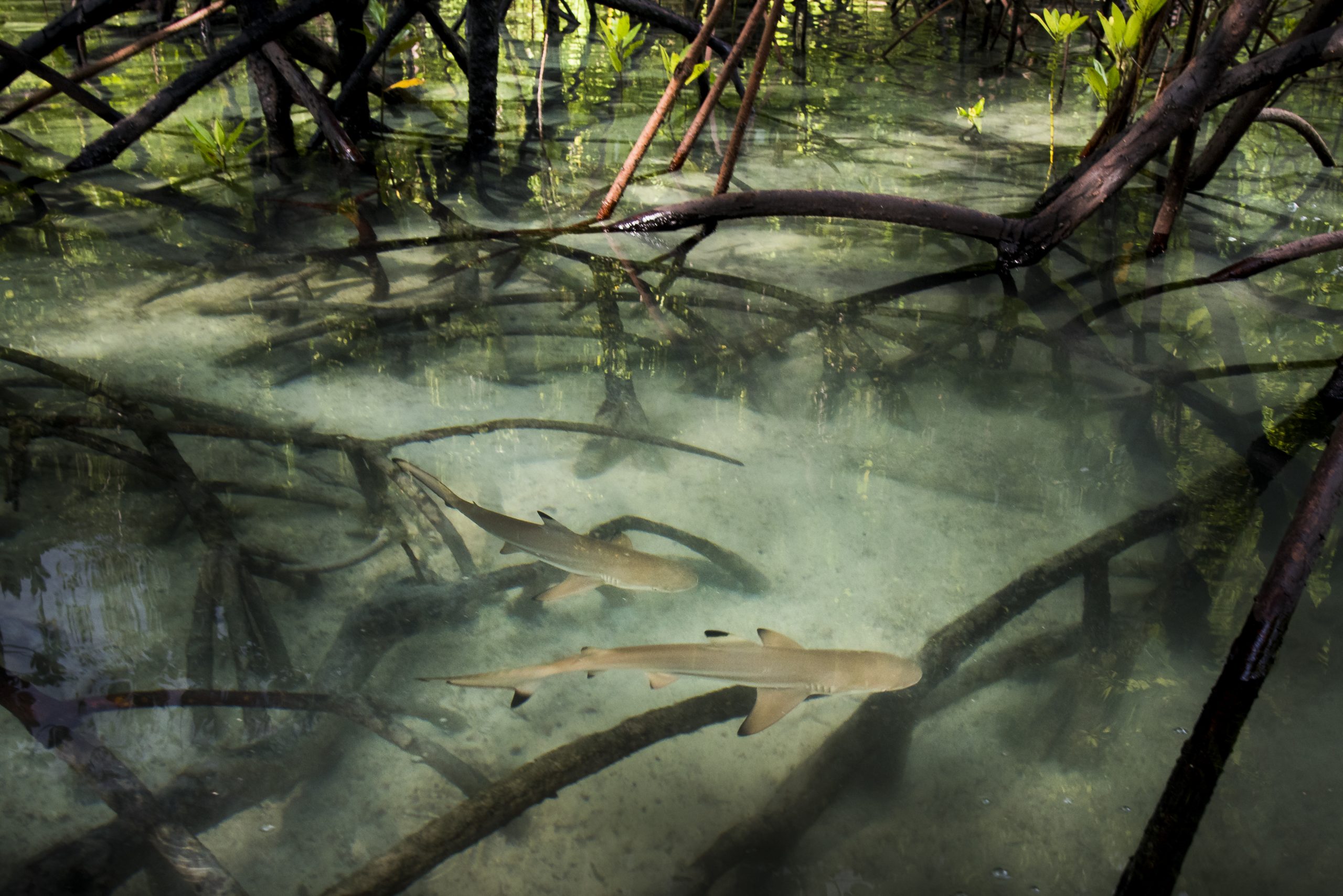Most people would say they do not like mangroves, while figuring in their heads a sort of hot and wet forests of strange-looking tress, flooded with salt water, mud, and swarms of mosquitoes. In reality, however, these fascinating ecosystems are much more than what people usually think about mangroves. Mangroves are coastal forests that develop in the intertidal zone (between the high and low tide levels) of tropical and subtropical regions around the world, composed by mangrove trees, which are a group of non-related trees and shrubs that growth and reproduce in soils with high salinity and low oxygen (1). These ecosystems are among of the most productive on the planet, and play important roles as nursery, resting, and feeding grounds for invertebrates (shrimps, crabs, gastropods and bivalves), bony fishes (snappers, groupers, snooks, and croakers or corvinas), rays and sharks, birds (egrets, frigate birds and pelicans), and mammals (tapirs, giant ant eaters, jaguars, sloths, and manatees) (2).

Source: globalwetlandsproject.org
Mangroves provide several goods and services to human communities. Settlements close to mangroves find their livelihoods in these forests. Many people obtain their protein from the several fishes and crustaceans they caught, and the harvesting of clams in the sedimentary bottoms, and oysters and mussels covering the mangrove’s roots. In many localities, mangrove trees provide wood to build houses, ships, and tools, and to harvest firewood and charcoal, and even drugs and dyers can be produced. Mangrove forests stand as natural barriers for coastline protection (against waves, hurricanes, and tsunamis) and waste water filtering before reaching the ocean (3). These ecosystems represent only 0.1% of Earth’s surface, but store tenfold more carbon than terrestrial forests (22.8 million metric tons per year), and take 14% of all the carbon sequestered by the Ocean.

Source: picture by Jack Eidt, in wilderutopia.co
Mangrove forests are found along the Southwest Caribbean littorals, where the most abundant species are the red mangrove (Rhizophora mangle), the black mangrove (Avicennia germinans), and the white mangrove (Laguncularia racemosa). Other mangrove species found in this region are the buttonwood mangrove (Conocarpus erectus), the kawi (Miskito language), cahué or dragonsblood tree (Pterocarpus officinalis), and the tea mangrove (Pelliciera rhizophorae) (4, 3, 5).

There are 12 mangrove lagoons in the Archipelago of San Andrés, Providencia and Santa Catalina, but despite the laws established to protected them, many have been destroyed by non-sustainable development or are currently threatened (6). In the Hondura’s Oriental region (7, 2, 3) and Nicaragua’s Caribbean coast (8, 9, 10), mangrove forests growth within an intricate complex of coastal barriers and lagoons, river mouths and estuaries, where bivalve harvesting is a common activity.
Mangroves are also found in the Miskito Cays and the Corn Islands in Nicaragua (11, 12). The Costa Rican Caribbean only has two mangrove forests, one well-developed in the Gandoca lagoon; and a degraded one close to Moín, dominated by dragonsblood tree (Pterocarpus officinalis) (4). In the Caribbean coast of Panamá, the largest and most developed mangroves are located at Bocas del Toro, where the connection between coral reefs, seagrass beds, and mangrove forests is very clear (13, 14). Further east, however, in the Guna Yala region mangroves are also common in islands and cays, and are locally called agligan (Kuna language). There, the most abundant species is the agliginnid (red mangrove), followed by the aglisibu (white mangrove), the aglisissid (black mangrove) and the ilessoo (buttonwood mangrove).

Despite their widely acknowledged biological, economic, and cultural importance, mangroves are currently one of the most threatened ecosystems with the fastest destruction rate. The main threats to these habitats are the agriculture frontier expansion, overfishing, river basins degradation, and the climate change.
References
(1) Hogarth PJ. 2015. The Biology of Mangroves and Seagrasses. Oxford University Press, Oxford.
(2) Gonthier DJ, Castañeda FE. 2013. Large-and medium-sized mammal survey using camera traps in the Sikre River in the Río Plátano Biosphere Reserve, Honduras. Tropical Conservation Science, 6(4), 584-591.
(3) Canty SW, Preziosi RF, Rowntree JK. 2018. Dichotomy of mangrove management: A review of research and policy in the Mesoamerican reef region. Ocean & Coastal Management, 157, 40-49.
(4) Cortés, J. (2016). The Caribbean coastal and marine ecosystems. En Kappelle M (ed.) Costa Rican Ecosystems, pp. 591-617. University of Chicago Press, Chicago.
(5) Nelson CH, Pérez HI. 2018. La familia Tetrameristaceae descubierta en Honduras. Ceiba, 55(1), 69-70.
(6) Murcia GA, González F, García MI, Lasso J. 2016. Angiosperm flag species for mangrove conservation in San Andrés island (Colombia) are highly vulnerable and locally rare. Caldasia, 38(1), 1-16.
(7) Glick D, Betancourt J. 1983. The Río Plátano Biosphere Reserve: Unique resource, unique alternative. Ambio, 12(3/4), 168-173.
(8) Nietschmann B. 1972. Hunting and fishing focus among the Miskito Indians, eastern Nicaragua. Human Ecology, 1(1), 41-67.
(9) Aguirre-Rubí JR, Ortiz-Zarragoitia M, Izagirre U, Etxebarria N, Espinoza F, Marigómez I. 2019. Prospective biomonitor and sentinel bivalve species for pollution monitoring and ecosystem health disturbance assessment in mangrove–lined Nicaraguan coasts. Science of The Total Environment, 649, 186-200.
(10) Jameson SC, Stevens K, Bennett RC. 2019. Nicaragua: Caribbean Coast. En: Sheppard C (ed.) World Seas: An Environmental Evaluation, pp. 725-741. Academic Press, Londres.
(11) Guadamuz N, Bloomfields MS. 2019. Composición florística y estructura del manglar de los Cayo Miskitos a 10 años después del huracán Félix. Revista Universitaria del Caribe, 22(1), 88-93.
(12) Salas RA, Castro WJO, Cuthbert MW. 2019. Análisis multitemporal de la cobertura de manglar en la Reserva Cayos Miskitos, 2006-2017. Revista Universitaria del Caribe, 22(1), 61-68.
(13) Guzman HM, Barnes PA, Lovelock CE, Feller IC. 2005. A site description of the CARICOMP mangrove, seagrass and coral reef sites in Bocas del Toro, Panama. Caribbean Journal of Science, 41, 430-440.
(14) Seemann J, Yingst A, Stuart-Smith RD, Edgar GJ, Altieri AH (2018). The importance of sponges and mangroves in supporting fish communities on degraded coral reefs in Caribbean Panama. PeerJ, 6, e4455.


